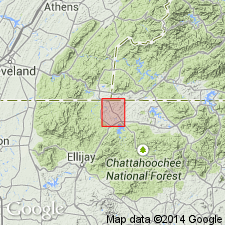
- Usage in publication:
-
- Mineral Bluff formation
- Modifications:
-
- Named
- Dominant lithology:
-
- Schist
- Slate
- Phyllite
- Conglomerate
- Meta-arkose
- AAPG geologic province:
-
- Piedmont-Blue Ridge province
Summary:
Named for Mineral Bluff, in Mineral Bluff quad, Fannin Co., northernmost GA. Resembles top of Andrews formation. Consists of fine-grained sequence of quartz-sericite schist, slate or phyllite and small amounts of graphitic schist and talcose schist. Metaconglomerate lenses, which help distinguish the sequence from Andrews formation, occur 100 to 200 ft above Nottely quartzite. Gradational contact with Nottely is seen at school house on east side of Mineral Bluff. Blue-gray slate is exposed in nearby flagstone quarry. Graphitic schist, talcose schist, and contact with Nottely are exposed northeast of Mineral Bluff along GA Hwy 60. Slate and sericite schist crop out along Dividing Ridge. Occupies trough of Murphy syncline. Top of formation is eroded. Thickness is 300 to 800 ft. Age is Cambrian.
Source: GNU records (USGS DDS-6; Reston GNULEX).
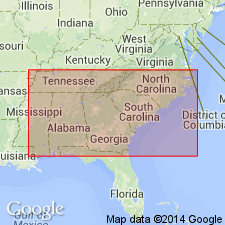
- Usage in publication:
-
- Mineral Bluff Formation
- Modifications:
-
- Revised
- AAPG geologic province:
-
- Piedmont-Blue Ridge province
Summary:
Nottely Quartzite is here redefined as a member of Mineral Bluff Formation, occurring at or near its base. Locally, a few tens of meters of metapelites belonging to the Mineral Bluff underlie the Nottely. These have been assigned previously to the underlying Andrews Formation. Because of a regional unconformity below the Mineral Bluff, it is removed from the Murphy Group in accordance with the Stratigraphic Code.
Source: GNU records (USGS DDS-6; Reston GNULEX).
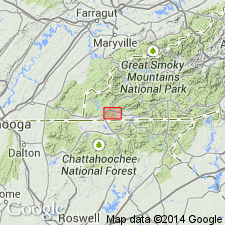
- Usage in publication:
-
- Mineral Bluff Group
- Modifications:
-
- Overview
- AAPG geologic province:
-
- Piedmont-Blue Ridge province
Summary:
Age of the Mineral Bluff Group, which unconformably overlies the Hiwassee River Group in the Murphy belt of NC and GA, is still in question. Rocks are undated paleontologically. Correlations depend upon estimate of metamorphic age of Mineral Bluff and age of underlying Murphy Marble. Most workers have correlated the Murphy Marble with the Shady Dolomite of Early Cambrian age, which would imply that the Mineral Bluff is Early Cambrian or younger. Age estimates for the metamorphic peak range between Middle Ordovician and Carboniferous, which would allow the Mineral Bluff to range in age between Early Cambrian and Carboniferous. A correlation with the Silurian-Early Devonian Talladega Group has been suggested by Tull and Guthrie (1983; 1985) and Tull and Groszos (1988; 1990) based on similarities in stratigraphic setting, lithology, and thickness. This includes a possible Lay Dam Formation-Mission Mountain Formation correlation, Butting Ram (Cheaha) Quartzite-Fort Butler Mountain Formation correlation, and Jemison Chert-Harshaw Bottom Quartzite correlation. Correlation between the Precambrian(?) Walden Creek Group and the Mineral Bluff Group has not been ruled out as both sequences are turbidite dominated and contain an abundance of carbonate detritus, among other similarities.
Source: GNU records (USGS DDS-6; Reston GNULEX).
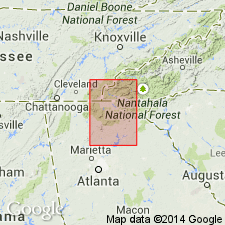
- Usage in publication:
-
- Mineral Bluff Group
- Modifications:
-
- Revised
- AAPG geologic province:
-
- Piedmont-Blue Ridge province
Summary:
After detailed field mapping of distinctive internal stratigraphy, authors propose that unit be raised to Mineral Bluff Group. Marble Hill Hornblende Schist is assigned to base of group. Mission Mountain, Fort Butler Mountain, Harshaw Bottom Quartzite, and Peachtree Creek Formation are newly named units of the Mineral Bluff above the Marble Hill. The Mineral Bluff overlies the Murphy Marble, here assigned to the top of the newly named Hiwassee River Group.
Source: GNU records (USGS DDS-6; Reston GNULEX).
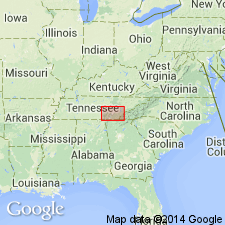
- Usage in publication:
-
- Mineral Bluff Formation
- Modifications:
-
- Revised
- AAPG geologic province:
-
- Piedmont-Blue Ridge province
Summary:
Used in map explanation as Mineral Bluff Formation of Hurst (1955).
[GNU remark (June 25, 1990, USGS DDS-6; Reston GNULEX): Given informal status. Not well described by Hurst (1955). Subsequent reports where it was used have only been abstracts or guidebook articles, or reports where it was mentioned casually.]
Source: GNU records (USGS DDS-6; Reston GNULEX).
For more information, please contact Nancy Stamm, Geologic Names Committee Secretary.
Asterisk (*) indicates published by U.S. Geological Survey authors.
"No current usage" (†) implies that a name has been abandoned or has fallen into disuse. Former usage and, if known, replacement name given in parentheses ( ).
Slash (/) indicates name conflicts with nomenclatural guidelines (CSN, 1933; ACSN, 1961, 1970; NACSN, 1983, 2005, 2021). May be explained within brackets ([ ]).

